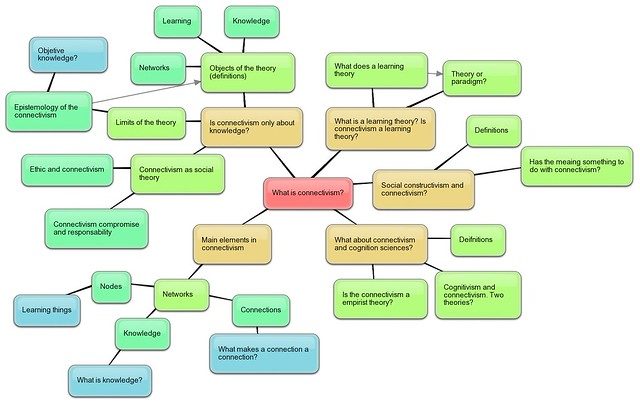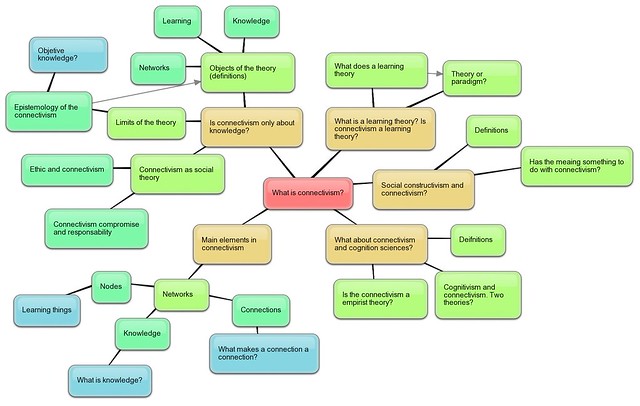Distributed Cognition as Pedagogical Movement

The beauty of a blog is that it provides one with a platform to express an opinion, to agree or disagree with the most brilliant of minds. The blog provides validity to a voice, although possibly an artificial one. For, who am I to say? I am just me; but this is my blog; so I get to say. But how do we sift through all of the voices – including our own? This is, I believe, what George Siemens is concerned about, when he addresses the need to synthesize fragmented information distributed online – to make meaningful connections – in order to avoid the problem of individual knowledge-seekers caught in a “private universal phenomenon of conceptually inappropriate views of the world” (Connectivism TEDxNYED, 3/6/2010).
The answer that George Siemens provides is Connectivism, an approach to learning design that begins with the recognition that our digital spaces allow us infinite paths to content and curriculum. From here, Siemens moves to the premise that knowledge must now be “seen as existing in networks, and learning as forming and navigating these networks” (Learning and Knowing in Networks: Changing roles for Educators and Designers, 2008). Through the “curatorial, atelier, concierge, and networked roles of educators” we must “collapse” or “centralize” the vast sea of information that is accessible in decentralized online environments down to points of connectedness (p. 3). The conduit for making these connection points is the technology itself; data networks are the pipelines – both literally and figuratively – to form the personal learning networks necessary for learners to access understanding.
No small task for teachers. No small task for technology. In fact, possibly Siemens would say that technology becomes the teacher, or at least the connector and collector of knowledge. These infinite technologically-formed networks become the storehouses for knowledge. One gets a sense that, if knowledge resides in these connections or networks, and if the networks reside in technology, then technology is the source of knowledge itself. Is this taking Connectivism to an extreme? I think that is exactly what Siemens is doing with his concept of “distributed cognition” (Siemens, 2008, p. 11).
Certainly technology is a complicated labyrinth that requires meaningful connection-making. Technology as a means and a mode of distributing information and communication shapes society, culture, and education, and could greatly benefit from some new highways and byways to improve its effectiveness as a learning tool. I agree with Siemens that technology and online “media fragments understanding” and that we need to find ways to “weave together narrative coherence that permits individual students and educators to relate well” (Connectivism TEDxNYED, 3/6/2010). But what are we to do with Siemens’s lofty and definitive statements: “Technology is philosophy. Technology is ideology” (emphasis his)? Would it be too great a leap for Siemens’s Connectivism to say that if we can harness technology, if we can “collapse” the online information stream into “a point of connectedness,” then we can unleash truth itself?
Or possibly Siemens is not attempting to define truth in terms of technology. Certainly his Connectivism: A learning theory for the digital age (2005) is focused on knowledge, even though it is an ever-fleeting goal because of its “shrinking half-life” (p. 1). But does this necessarily mean that knowledge only exists within personal learning networks? Is there only network “distributed cognition” and no other internal, or even external, places to discover, even acquire, knowledge?
Undoubtedly, technology is a core element of any educational enterprise in our media age. We do indeed need new pedagogical pathways for navigating our digital spaces. As Jennifer Englund explains, Siemens first presented Connectivism because he felt a new theory was needed “that addresses the exponential growth and complexity of information available on the internet, new possibilities for global communication, and the ability to aggregate different information streams” (What is the theory of connectivism?” (10/14/2013). My only difficulty here lies in the term “theory,” since Connectivism, in my view, does not explain learning and knowledge acquisition (or the lack thereof), as much as it gives us a new route and new transportation tools toward learning. In this way, Connectivism is more of a learning design or methodology. So I need to side with Pløn Verhagen (2006) and Bill Kerr (2007), among others, who see Connectivism as pedagogy rather than theory (Siemens, 2008, p. 11).
But Connectivism as practice and pedagogy rather than theory assigns an important role to each of us in education. Siemens (20008) spells this out clearly: “First, teachers interact with learners and content in a different manner. The internet has caused a power shift in classrooms, as learners now have greater access information, experts, and peer learners. Secondly, instructional designers, due to the developing complexity of tools and availability of open education resources, play an educational role of directing educators to tools and resources” (p. 19). Taken as a pedagogical movement, Connectivism is worth joining and its methods worth adopting. Not as the only way to aggregate and distribute knowledge, but certainly a most promising one.
